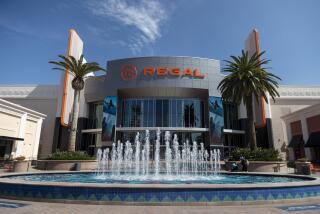COMPANY TOWN : A Scarlet-Letter Day for Struggling Cinergi Pictures
It seems appropriate that the latest big-budget movie from Cinergi Pictures is “The Scarlet Letter,” which opens in theaters today. The production company has been mired in red ink lately, despite having this year’s biggest-grossing film to date worldwide, “Die Hard With a Vengeance.”
Such are the ironies of independent production companies. Take Carolco Pictures, which made some of the biggest-grossing films ever--”Terminator 2: Judgment Day,” “Basic Instinct” and the “Rambo” series. Despite that track record, the financially ailing company is on life support, in part because of an inability to keep its big-spending ways in check.
With companies such as Carolco, Savoy Pictures Entertainment and Samuel Goldwyn Co. now struggling--and memories still fresh from such debacles as Weintraub Entertainment Group, Orion Pictures and De Laurentiis Entertainment Group--it’s no wonder that investors are drawn to Hollywood’s blue-chip firms, such as Walt Disney Co.
Cinergi Chief Executive Andrew G. Vajna, who also co-founded Carolco in 1975, says he’s learned the lessons to be found in the rubble heap of smaller entertainment companies that have failed. He says those firms typically overextended themselves, padded their payrolls with unnecessary workers and let their excesses get the better of them.
He and his top financial executive, Warren Braverman, another Carolco alumnus, say their business plans involve limiting their risks and making sure the company gets a decent piece of the financial pie when they make a hit. In addition, the employee roster is kept short, with only 30 people working full-time at a company that by December will boast of four major releases this year.
But when a business plan mandates big-budget event movies, there’s no escaping risk. Indeed, that very word is emblazoned on the front of the company’s Santa Monica headquarters, which is fashionably spray-painted with mock graffiti.
The risky, effects-laden “Judge Dredd,” a Sylvester Stallone futuristic action film that reportedly cost about $80 million and that Cinergi was counting on to become a multi-picture franchise, bombed at the box office this summer. For the six months ended June 30, Cinergi lost $9.2 million, largely because of “Dredd,” and would have posted an even bigger loss had the red ink not been offset by profit from “Die Hard.” That $102-million Bruce Willis film has grossed $350 million worldwide to date.
The company’s stock, which had soared above $11 a share earlier this year, has dropped to $4.625, where it closed Thursday in Nasdaq trading. Unless things turn around, Cinergi could prove yet another painful example of the perils of investing in Hollywood production companies, where a single hit can send a stock soaring and a few turkeys can sink it.
When Cinergi went public in June, 1994, it was riding the success of “Tombstone,” which boosted company profit to $2.9 million for the year. Within a few months, “Renaissance Man” and “Color of Night” flopped. In May, the company netted $23.5 million by selling another 3 million shares.
Cinergi was founded by Hungarian immigrant Vajna, who fled to the United States via Canada after the 1956 uprising against the Russians. It lost about $27 million between its 1989 inception and 1993, largely because of costs associated with getting the company off the ground. Vajna bankrolled the company with some off the $106 million he reportedly received when he cashed out of Carolco when that company was thriving.
At Carolco, Vajna and his former partner, Mario Kassar, refined the art of pre-selling movies in foreign markets to lower the risk of the big-budget movies they like to make. By getting advances from distributors in countries such as Japan, Italy and France before a film is finished, the cost of production is partly--sometimes fully--covered by the time the movie hits the screen.
Vajna is using the same strategy at Cinergi to blunt the potential impact of a bomb such as “Dredd.” In the case of “Scarlet Letter”--which sources say cost about $45 million to make--Cinergi’s exposure is less than $5 million, Braverman says. The Roland Joffe-directed film stars Demi Moore, Gary Oldman and Robert Duvall, and takes various liberties with the Nathaniel Hawthorne classic.
It helps that Cinergi has Walt Disney Co. looking out for its interests. Under a long-term distribution deal, sources say, Disney puts up between 30% and 35% of the negative costs for each Cinergi-produced film, up to about $20 million, in exchange for the North American and Latin American rights. Additionally, Disney kicks in the money for the film prints and marketing costs domestically.
*
Disney has another reason for wanting Cinergi to do well. The company owns Cinergi stock, albeit less than 5%.
Vajna and Braverman counter skepticism about Cinergi’s plans by noting that the company’s strategy is more conservative than that of other publicly held production companies, because of its covering a good part of the production budget through the foreign sales. But that hedge strategy also raises the question of just how much upside is left for Cinergi and its investors when a movie is a hit.
“It is a worthwhile give-up for protection of our downside,” said Vajna, who adds that “we divide up the risk so it’s manageable for everybody. . . . Nobody is taking a huge risk.”
Another cautionary strategy is to resist the temptation to expand into areas such as television. “Our focus is to keep our overhead down and make four to five successful event movies a year,” Vajna said.
One senior Hollywood executive who has done business with Cinergi says that although Vajna is “the best salesman out there,” he should re-evaluate his strategy because the size of the budgets for films he likes to make have practically doubled since the early 1980s. Then, $50 million seemed huge. Now that’s the industry average to make and market a major studio movie.
Braverman counters that it’s no trickier to cover the costs of a $90-million movie today through foreign sales than it was to cover a big-budget film a few years back. But he acknowledges that it’s more difficult today to make a high-quality picture on a reasonable budget.
In the case of “Dredd,” Cinergi took the brunt of the risk and suffered from bloated special-effects costs. “We spent more money than anticipated,” Vajna says. That included buying a visual effects operation in Massachusetts used in creating a midair motorcycle chase that wasn’t in the original script.
Braverman said the company has no risk on its upcoming Oliver Stone film “Nixon,” starring Anthony Hopkins, because of strong sales of the film overseas in anticipation of its December release. It’s not clear yet how much, if any, exposure the company will have on another major project, the long-stalled musical “Evita,” starring Madonna and Antonio Banderas, due out in December, 1996.
*
The soft-spoken Vajna, who rarely works without a lighted cigar in his fingers, houses his operation in a renovated industrial building once owned by Stallone and that Vajna himself now owns and leases to Cinergi. He dresses casually in jeans--a product he once made in Hong Kong and sold before he caught the film bug. Vajna has done well for himself, owning a profitable casino and a film distributor in Hungary.
Some critics have said he’s doing too well. In addition to owning nearly 50% of Cinergi, Vajna draws a $1-million annual salary, gets a $125,000 fee when shooting begins on a picture (up to $250,000 a year) and gets 3% of the profit himself after all costs are subtracted.
His original Cinergi contract called for a yacht during the Cannes Film Festival “to be of a size and of a standard comparable” to yachts Vajna had chartered at Cannes before. Sensitive to criticism, Cinergi and Vajna agreed to delete that perk.
In his defense, Vajna says, “I’m probably the lowest-paid executive in the business” compared to other top producers.
“My goal is not to rape this company,” he said, “but to build equity for myself and the investors.”
(BEGIN TEXT OF INFOBOX / INFOGRAPHIC)
Downhill Slide:
Cinergi Pictures’ losses have led to steep delices in stock price. Monthly highs, except latest: Thursday: $4.625
Source: TradeLine
More to Read
The biggest entertainment stories
Get our big stories about Hollywood, film, television, music, arts, culture and more right in your inbox as soon as they publish.
You may occasionally receive promotional content from the Los Angeles Times.










